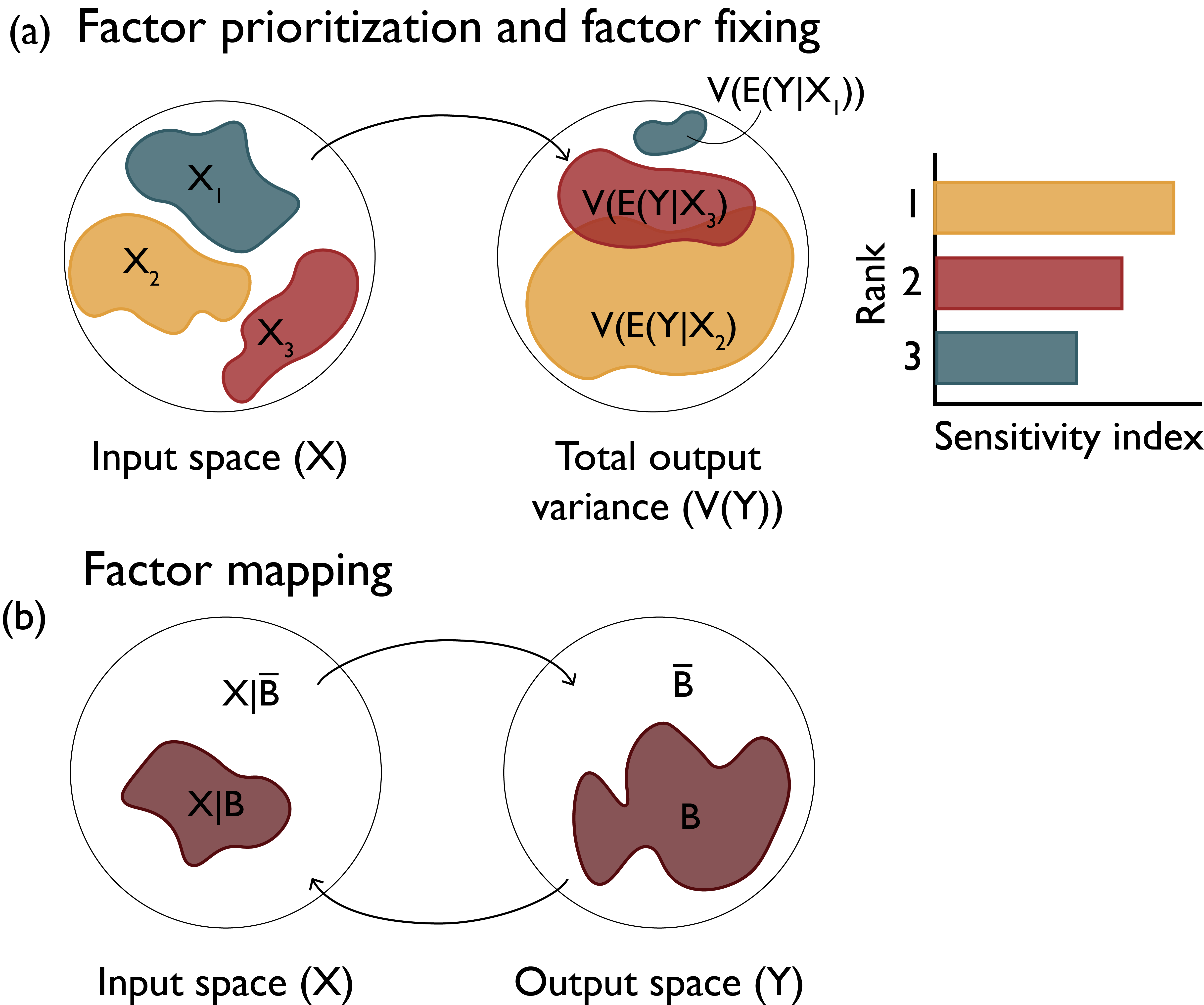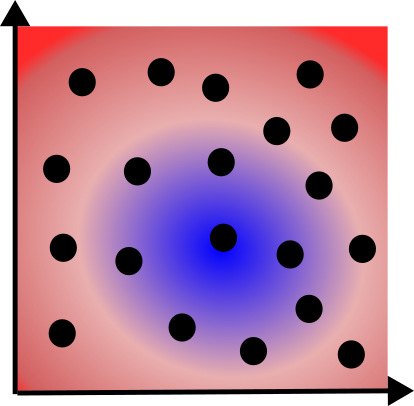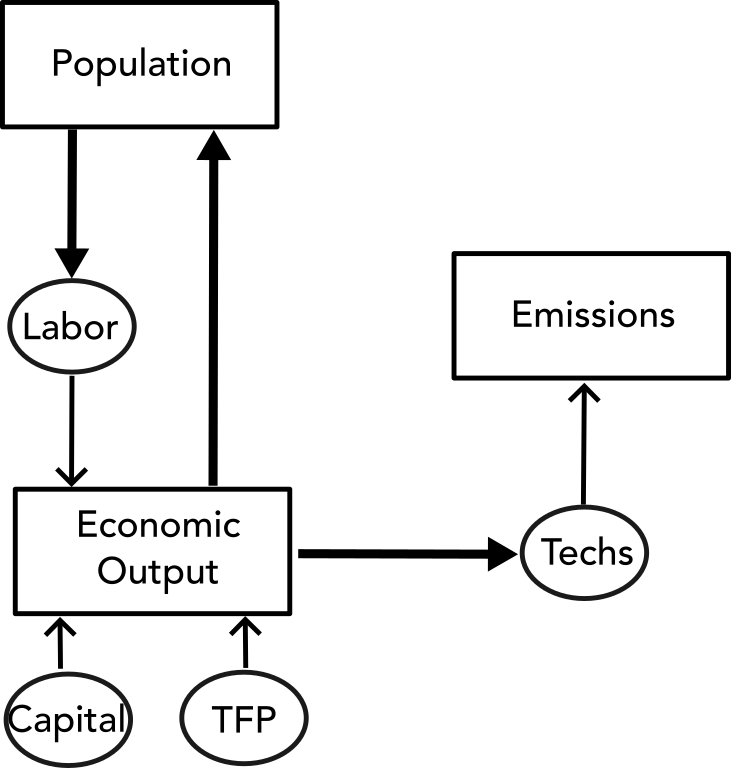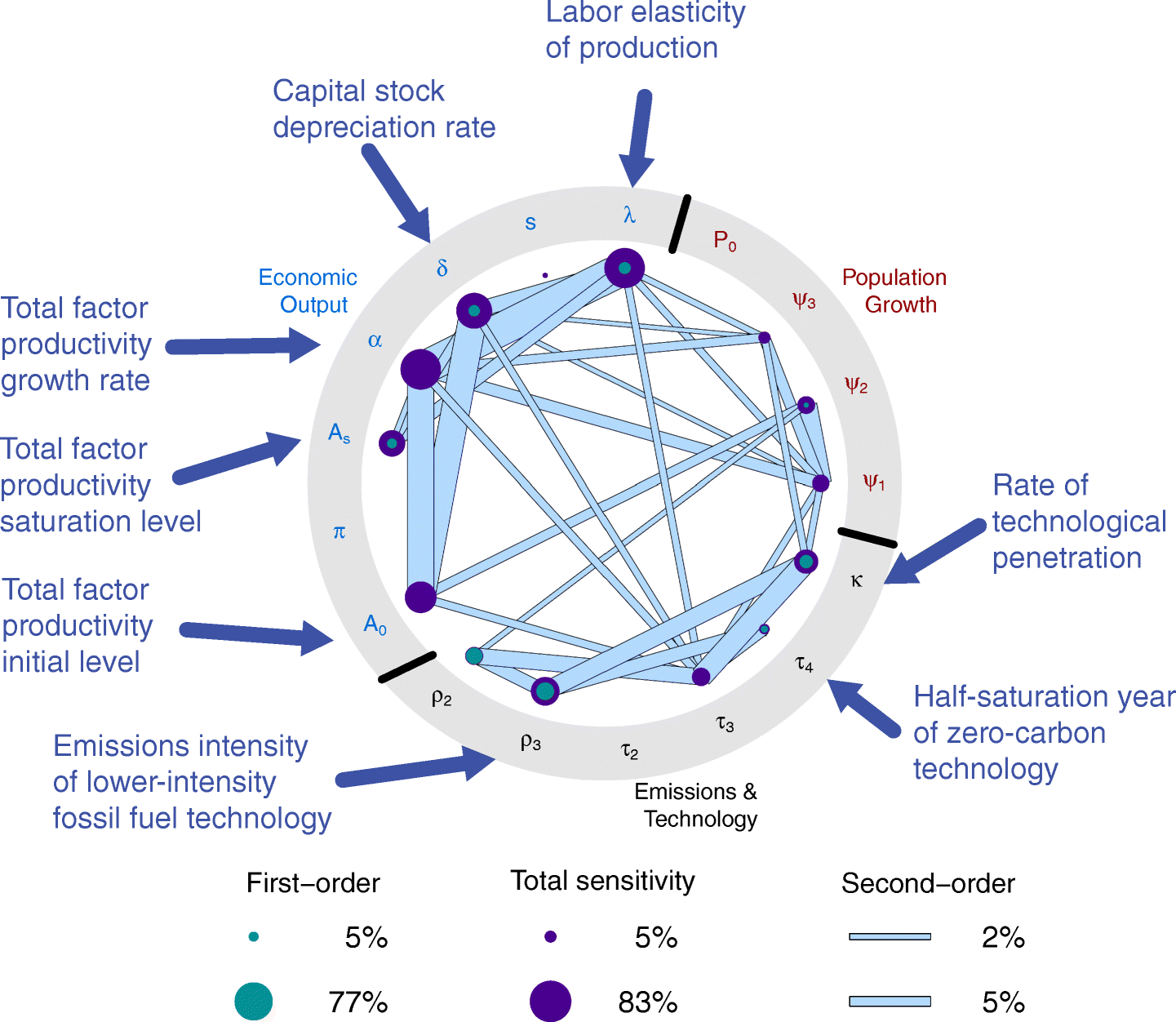class: center, middle .title[Introduction to Sensitivity Analysis] <br> .subtitle[BEE 4750/5750] <br> .subtitle[Environmental Systems Analysis, Fall 2022] <hr> .author[Vivek Srikrishnan] <br> .date[November 9, 2022] --- name: toc class: left # Outline <hr> 1. Project Due Dates 2. Questions? 3. Introduction to Sensitivity Analysis --- name: poll-answer layout: true class: left # Poll <hr> .left-column[{{content}} URL: [https://pollev.com/vsrikrish](https://pollev.com/vsrikrish) Text: **VSRIKRISH** to 22333, then message] .right-column[.center[]] --- name: questions template: poll-answer ***Any questions?*** --- layout: false # Last Class <hr> * Robustness * Satisfycing and Regret-Based Measures --- class: left # Prioritizing Factors of Interest <hr> Many parts of a systems-analysis workflow involve potentially large numbers of modeling assumptions, or *factors*: * Monte Carlo simulation * Simulation-Optimization * Robustness of decisions Every additional factor considered increases computational expense and analytic complexity. --- class: split-40 # Prioritizing Factors of Interest <hr> .column[ Key question: *How do we know which factors are most relevant to a particular analysis?* or *What modeling assumptions were most responsible for output uncertainty?* ] .column[ .center[ .center[.cite[Source: [Saltelli et al (2019)](https://doi.org/10.1016/j.envsoft.2019.01.012)]] ] ] --- # Sensitivity Analysis <hr> This question is commonly addressed using **sensitivity analyses**. --- name: questions template: poll-answer ***What do you think of when you hear "sensitivity analysis"?*** --- layout: false # Sensitivity Analysis <hr> Sensitivity analysis is... > the study of how uncertainty in the output of a model (numerical or otherwise) can be apportioned to different sources of uncertainty in the model input > > .footer[- Saltelli et al (2004), *Sensitivity Analysis in Practice*] --- name: sa-why layout: true # Why Perform Sensitivity Analysis? <hr> .left-column[ {{content}} ] .right-column[ .center[] .center[.cite[Source: [Reed et al (2002)](https://uc-ebook.org/)]] ] --- template: sa-why **Factor Prioritization**: Which factors have the greatest impact on output variability? --- template: sa-why **Factor Fixing**: Which factors have negligible impact and can be fixed in subsequent analyses? --- template: sa-why **Factor Mapping**: Which values of factors lead to model outputs in a certain output range? --- layout: false # Shadow Prices Are Sensitivities <hr> We've seen one example of a quantified sensitivity before: **the shadow price of an LP constraint.** The shadow price expresses the objective's sensitivity to a unit relaxation of the constraint. -- **For example (HW3)**: how much money could be saved with a unit reduction of a CO<sub>2</sub> constraint. --- # Types of Sensitivity Analysis <hr> * One-at-a-Time vs. All-At-A-Time Sampling * Local vs. Global --- # One-at-a-Time Sampling <hr> **Assumption**: Factors are linearly independent (no interactions). **Benefits**: Easy to implement and interpret. **Limits**: Ignores potential interactions. --- # All-At-A-Time Sampling <hr> Number of different sampling strategies: full factorial, Latin hypercubes, more. **Benefits**: Can capture interactions between factors. **Challenges**: Can be computationally expensive, does not reveal where key sensitivities occur. --- class: split-40 # Local vs. Global <hr> .column[ **Local** sensitivities: Pointwise perturbations from some baseline point. Challenge: *Which point to use?* ] .column[ .center[] ] --- class: split-40 # Local vs. Global <hr> .column[ **Global** sensitivities: Sample throughout the space. Challenge: *How to measure global sensitivity to a particular output?* Advantage: *Can estimate interactions between parameters* ] .column[ .center[] ] --- # How to Calculate Sensitivities? <hr> Number of approaches. Some examples: * Derivative-based or Elementary Effect (*Method of Morris*) * Regression * Variance Decomposition or ANOVA (*Sobol Method*) * Density-based (*$\delta$ Moment-Independent Method*) For our subsequent examples, we will look at *global* analyses with *variance decomposition* (Sobol method). --- # Example: Lake Problem <hr> For a fixed release strategy, look at how different parameters influence reliability. Take $a_t=0.03$, and look at the following parameters within ranges: | Parameter | Range | |:---------:|:---------------------------:| | $q$ | $(2, 3)$ | | $b$ | $(0.3, 0.5)$ | | $ymean$ | $(\log(0.01), \log)(0.07))$ | | $ystd$ | $(0.01, 0.25)$ | --- # Method of Morris <hr> The Method of Morris is an *elementary effects* method. This is a global, one-at-a-time method which averages effects of perturbations at different values $\bar{x}_i$: $$ S\_i = \frac{1}{r} \sum\_{j=1}^r \frac{f(\bar{x}^j\_1, \ldots, \bar{x}^j\_i + \Delta\_i, \bar{x}^j\_n) - f(\bar{x}^j\_1, \ldots, \bar{x}^j\_i, \ldots, \bar{x}^j\_n)}{\Delta\_i} $$ where $\Delta\_i$ is the step size. --- class: split-50 # Method of Morris for the Lake Problem <hr> .left-column[ ```julia using GlobalSensitivity s = gsa(lake_sens, Morris(), [(2, 3), (0.3, 0.5), (log(0.01), log(0.07)), (0.01, 0.25)]) abs.(s.means) ``` ``` 1×4 Matrix{Float64}: 0.0 14.6025 0.632512 0.265179 ``` ```julia s.variances ``` ``` 1×4 Matrix{Float64}: 0.0 3807.7 14.219 1.56039 ``` ] .right-column[ .center[] ] --- # Sobol Method <hr> The Sobol method is a variance decomposition method, which attributes the variance of the output into contributions from individual parameters or interactions between parameters. $$ S\_i^1 = \frac{Var\_{x\_i}\left[E\_{x\_{\sim i}}(x\_i)\right]}{Var(y)} $$ $$ S\_{i,j}^2 = \frac{Var\_{x\_{i,j}}\left[E\_{x\_{\sim i,j}}(x\_i, x\_j)\right]}{Var(y)} $$ --- # Sobol for Lake Problem <hr> ```julia using GlobalSensitivity s = gsa(lake_sens, Sobol(order=[0, 1, 2], nboot=10), [(2, 3), (0.3, 0.5), (log(0.01), log(0.07)), (0.01, 0.25)]; samples = 100) s.ST' ``` ``` 1×4 adjoint(::Vector{Float64}) with eltype Float64: 0.530738 0.501809 0.524217 0.00175402 ``` ```julia s.ST_Conf_Int' ``` ``` 1×4 adjoint(::Vector{Float64}) with eltype Float64: 0.0242332 0.0359234 0.0335532 0.00620357 ``` --- # Sobol for Lake Problem <hr> .left-column[ ```julia s.S1' ``` ``` 1×4 adjoint(::Vector{Float64}) with eltype Float64: 0.188526 0.211777 0.240895 0.0202776 ``` ```julia s.S1_Conf_Int' ``` ``` 1×4 adjoint(::Vector{Float64}) with eltype Float64: 0.0382975 0.0306325 0.0503465 0.00936398 ``` ] .right-column[ ```julia s.S2 ``` ``` 4×4 Matrix{Float64}: 0.0 0.0797998 0.0890505 0.101581 0.0 0.0 0.0288883 0.0210389 0.0 0.0 0.0 -0.0345652 0.0 0.0 0.0 0.0 ``` ```julia s.S2_Conf_Int ``` ``` 4×4 Matrix{Float64}: 0.0 0.0525682 0.0506765 0.034552 0.0 0.0 0.0593496 0.0424066 0.0 0.0 0.0 0.0522533 0.0 0.0 0.0 0.0 ``` ] --- # Example: Cumulative CO<sub>2</sub> Emissions <hr> .center[] --- # Example: Cumulative CO<sub>2</sub> Emissions <hr> .center[] .center[.cite[Source: [Srikrishnan et al (2022)](https://doi.org/10.1007/s10584-021-03279-7)]] --- # What Next? <hr> **Factor prioritization/fixing**: inform Monte Carlo or model simplification **Factor mapping**: Scenario discovery, identify key parameters leading to outcomes of interest --- # Key Takeaways <hr> * Sensitivity Analysis involves attributing variability in outputs to input factors. * Factor prioritization, factor fixing, factor mapping are key modes. * Different types of sensitivity analysis: choose carefully based on goals, computational expense, input-output assumptions. * Many resources for more details. --- class: middle <hr> # Next Class <hr> * Decision-Making Under Uncertainty: Decision Trees